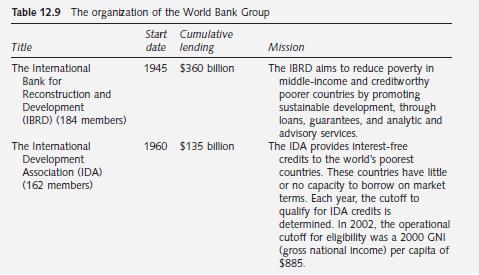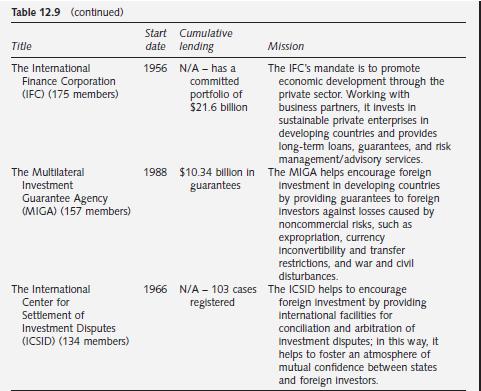Representatives of 44 governments founded the World Bank on July 1, 1944, during their conference at Bretton
Question:
Representatives of 44 governments founded the World Bank on July 1, 1944, during their conference at Bretton Woods, New Hampshire. The Bank is a sister institution to the International Monetary Fund (IMF), but has a separate, distinct objective. The Bank was largely the brainchild of the economist John Maynard Keynes, who envisioned an institution that would initially focus on postwar reconstruction in Europe and Asia and then shift to focusing on development of poor countries. As such, the Bank’s overriding modern purpose is to spur development worldwide through loans and grants to underdeveloped countries. To help stress this goal, the mission statement of the Bank is the elegant and simple sentence: “Our dream is a world free from poverty.”
The Bank consists of 184 countries that all share this goal. Membership of the Bank is only allowed for countries that are first members of the IMF. Typically, countries join both organizations.
Member countries are shareholders who carry ultimate decision-making power in the World Bank. Each member nation appoints a Governor and an Alternate Governor to carry out these responsibilities. The Board of Governors, who are usually officials such as Ministers of Finance or Planning, meets annually at the Bank’s Meetings each fall. The chairperson of the Board of Governors is the President of the World Bank. The governors decide on key Bank policy issues, admit or suspend country members, decide on changes in the authorized capital stock, determine the distribution of income, and endorse financial statements and budgets.
Specifically, their policy discussions during the annual meetings cover a variety of issues, such as poverty reduction, international economic development, and global development finance. This annual gathering provides a forum for international cooperation and enables the Bank to better serve its member countries. The meetings are traditionally held in Washington two years out of three and, in order to reflect the international character of the two institutions
(the World Bank and the IMF), every third year in a different member country.
Because these ministers meet only once a year, the bulk of the Governors’ powers are delegated throughout the year to the Board of Executive Directors. Every member government of the World Bank Group is represented at the Bank’s headquarters in Washington, DC, by an Executive Director. The five largest shareholders – France, Germany, Japan, the UK, and the USA – each appoint an Executive Director, while the other member countries are represented by 19 Executive Directors who are elected by groups of countries (constituents). Some countries
– China, Russia, and Saudi Arabia – have formed single-country constituencies, while others have joined together in multi-country constituencies. The 24 Executive Directors normally meet twice a week to oversee the Bank’s business, such as loan applications and guarantees, new policies, the administrative budget, country assistance strategies, and borrowing and financial decisions.
The World Bank is part of a larger organization, the World Bank Group. The World Bank Group consists of five closely associated institutions, all owned by member countries that carry ultimate decision-making power. As explained below, each institution plays a distinct role in the mission to fight poverty and improve living standards for people in the developing world.
The term “World Bank Group” encompasses all five institutions. The term “World Bank” refers specifically to two of the five, the International Bank for Reconstruction and Development (IBRD) and the International Development Association (IDA). Table 12.9 shows a brief summary of each organization that makes up the World Bank Group.
The Bank has taken some specific actions that it rightly boasts about. It has become the world’s largest external funder of education. Since its education funding began in 1963, the World Bank has provided some $31 billion in loans and credits, and it currently finances 158 education projects in 83 countries. It is also the largest external funder of the fight against AIDS/HIV. As a co-sponsor of UNAIDS, which coordinates the global response to the epidemic, the Bank has committed more than $1.7 billion to combating the spread of HIV/AIDS around the world. The Bank has pledged that no country with an effective HIV/AIDS strategy will go without funding and, in partnership with African governments, it has launched the Multi-
Country HIV/AIDS Program (MAP), which makes significant resources available to civil society organizations and communities.
Case Questions 1 Table 12.9 summarizes the five organizations of the World Bank Group, and this chapter has discussed the Asian financial crisis. How might each part of the World Bank Group have helped after the crisis started?


2 Many critics claim that the World Bank Group is too large and attempts to do too much.
Additionally, they claim that many of the Bank’s activities overlap with the work of the World Trade Organization, the International Monetary Fund, and the United Nations. How valid do you find this criticism?
3 Imagine that you are the President of the World Bank. Who are your most powerful constituents?
How much power do you have? Would you want this job?
4 What are the major differences between the IMF and the World Bank?
5 Visit the World Bank’s website, www.worldbank.org, to discover its current projects.
Step by Step Answer:

Global Corporate Finance Text And Cases
ISBN: 9781405119900
6th Edition
Authors: Suk H. Kim, Seung H. Kim





